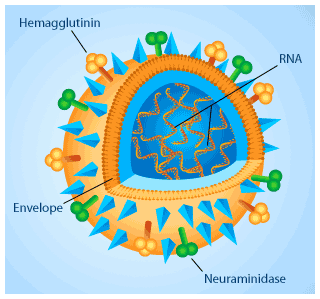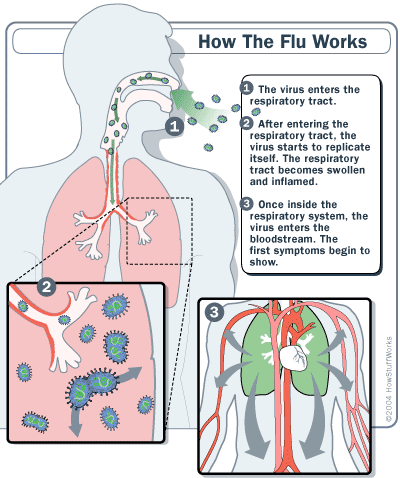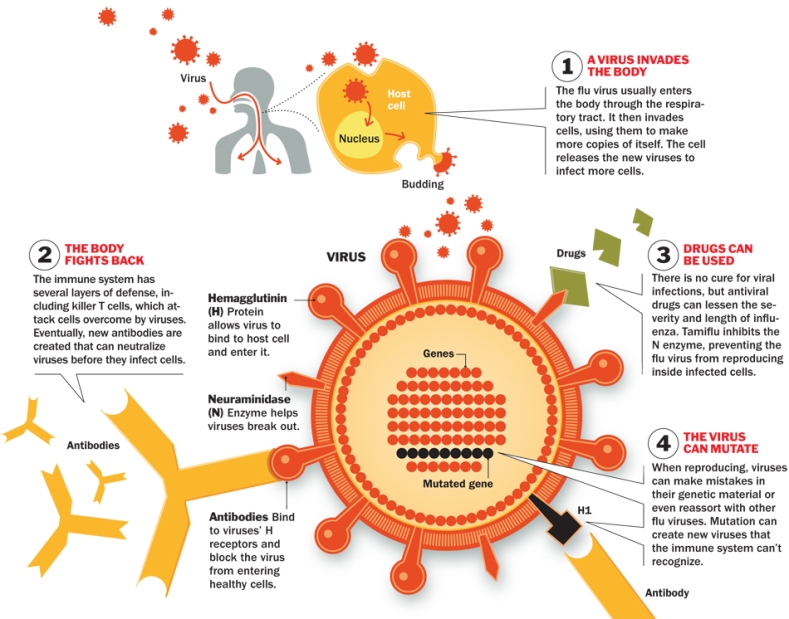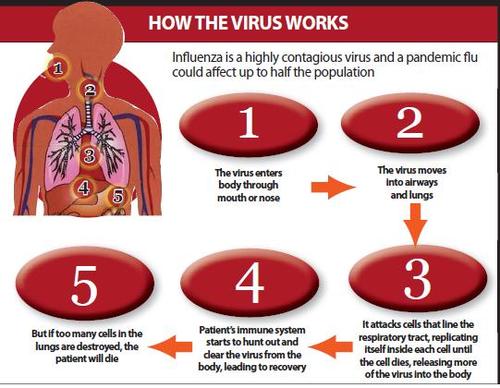
|
||||||||||||
|
|
|
The Flu -Influenza The flu is an illness caused by a virus. Like a cold, it attacks the nose, throat, and lungs. The flu can sometimes lead to other problems like pneumonia, ear and sinus problems, dehydration, and worsening of asthma. For most of us, the flu will go away in one-two weeks.
Neuraminidase and hemagglutinin are proteins found on the envelope, or coat, of the virus that help the virus to lock on to and invade its target cells. Flu Terms DefinedSeasonal (or common) flu is a respiratory illness that can be transmitted person to person. Most people have some immunity, and a vaccine is available. Avian (or bird) flu is caused by influenza viruses that occur naturally among wild birds. The H5N1 variant is deadly to domestic fowl and can be transmitted from birds to humans. There is no human immunity and no vaccine is available. Pandemic flu is virulent human flu that causes a global outbreak, or pandemic, of serious illness. Because there is little natural immunity, the disease can spread easily from person to person.
Flu PrimerEvery year in the United States, on average:
|
|
|
Complications of Flu
Complications of flu can include bacterial pneumonia, ear infections, sinus infections, dehydration, and worsening of chronic medical conditions, such as congestive heart failure, asthma, or diabetes.
How Flu Spreads
Flu viruses spread mainly from person to person through coughing or sneezing of people with influenza. Sometimes people may become infected by touching something with flu viruses on it and then touching their mouth or nose. Most healthy adults may be able to infect others beginning 1 day before symptoms develop and up to 5 days after becoming sick. That means that you may be able to pass on the flu to someone else before you know you are sick, as well as while you are sick.
What We Know About the Flu Virus
A flu virus is roughly round, but it can also be elongated or irregularly shaped. Inside are eight segments of single-strand RNA containing the genetic instructions for making new copies of the virus. Flu's most striking feature is a layer of spikes projecting from its surface. There are two different types of spikes: one is the protein hemagglutinin (HA), which allows the virus to "stick" to a cell and initiate infection, the other is a protein called neuraminidase (NA), which enables newly formed viruses to exit the host cell.
Virus A, B, C
Influenza viruses are classified as type A, B, or C based upon their protein composition. Type A viruses are found in many kinds of animals, including ducks, chickens, pigs, whales, and also in humans. The type B virus widely circulates in humans. Type C has been found in humans, pigs, and dogs and causes mild respiratory infections, but does not spark epidemics.
Type A influenza is the most frightening of the three. It is believed responsible for the global outbreaks of 1918, 1957 and 1968. Type A viruses are subdivided into groups based on two surface proteins, HA and NA. Scientists have characterized 16 HA subtypes and 9 NA subtypes.
Naming Viral Strains
Type A subtypes are classified by a naming system that includes the place the strain was first found, a lab identification number, the year of discovery, and, in parentheses, the type of HA and NA it possesses, for example, A/Hong Kong/156/97 (H5N1). If the virus infects non-humans, the host species is included before the geographical site, as in A/Chicken/Hong Kong/G9/97 (H9N2). There are no type B or C subtypes.
Where Influenza Comes From
In nature, the flu virus is found in wild aquatic birds such as ducks and shore birds. It has persisted in these birds for millions of years and does not typically harm them. But the frequently mutating flu viruses can readily jump the species barrier from wild birds to domesticated ducks and then to chickens. From there, the next stop in the infectious chain is often pigs.
Pigs can be infected by both bird (avian) influenza and the form of influenza that infects humans. In a setting such as a farm where chickens, humans and pigs live in close proximity, pigs act as an influenza virus mixing bowl. If a pig is infected with avian and human flu simultaneously, the two types of virus may exchange genes. Such a "reassorted" flu virus can sometimes spread from pigs to people.
Depending on the precise assortment of bird-type flu proteins that make it into the human population, the flu may be more or less severe.
In 1997, for the first time, scientists found that bird influenza skipped the pig step and infected humans directly. Alarmed health officials feared a worldwide epidemic (a pandemic). But, fortunately, the virus could not pass between people and thus did not spark an epidemic. Scientists speculate that chickens may now also have the receptor used by human-type viruses.
Drifting and Shifting
Influenza virus is one of the most changeable of viruses. These genetic changes may be small and continuous or large and abrupt.
Small, continuous changes happen in type A and type B influenza as the virus makes copies of itself. The process is called antigenic drift. The drifting is frequent enough to make the new strain of virus often unrecognizable to the human immune system. For this reason, a new flu vaccine must be produced each year to combat that year's prevalent strains.
Type A influenza also undergoes infrequent and sudden changes, called antigenic shift. Antigenic shift occurs when two different flu strains infect the same cell and exchange genetic material. The novel assortment of HA or NA proteins in a shifted virus creates a new influenza A subtype. Because people have little or no immunity to such a new subtype, their appearance tends to coincide with very severe flu epidemics or pandemics.
Habits for Good Health
These steps may help prevent the spread of respiratory illnesses such as the flu:
Cover your nose and mouth with a tissue when you cough or sneeze—throw the tissue away after you use it.
- Wash your hands often
with soap and water, especially after you cough or sneeze. If you are
not near water, use an alcohol-based hand cleaner.
- Avoid close contact
with people who are sick. When you are sick, keep your distance from
others to protect them from getting sick too.
- If you get the flu,
stay home from work, school, and social gatherings. In this way you
will help prevent others from catching your illness.
- Try not to touch your eyes, nose, or mouth. Germs often spread this way.
How can I catch the flu?
- The flu is easily passed from person to person by coughing and sneezing.
- A person can also get the flu by touching something with the flu virus on it and then touching their mouth or nose.
Who is most at risk for getting the flu?
Everyone is at risk for getting the flu, but for some people the flu can cause serious illness. Those most at risk include:
- Older adults (over age 65)
- Pregnant women
- Very young children
- Adults and children (6 months and older) who have heart or lung disease, including asthma.
- Adults and children (6 months and older) who have diabetes, kidney or blood problems.
- People with HIV/AIDS, cancer or any condition that make it harder to fight off disease
- Children and teens (6 months to 18 years) who take aspirin for a long time
- People who live in nursing homes and other health care facilities
- Workers in hospitals or clinics who are around lots of people who have the flu. These people should contact their doctor or clinic if they have flu-like symptoms.
What are the signs of the flu?
- Fever
- Headache and muscle ache
- Tiredness
- Cough
- Sore throat
- Runny or stuffy nose
- Throwing up or diarrhea (more common in children).
How well does the flu shot work?
- The shot prevents the flu in 70% to 90% of young, healthy adults.
- The shot doesn’t do as well at preventing flu in older adults and people with certain medical problems. But the shot does reduce the number of these people who die or need a hospital stay because of the flu.
People who are allergic to eggs or who have had a reaction to the flu shot or vaccine should not be given the flu shot or nasal flu spray. Also, talk to your doctor if you have a history of Guillain-Barré syndrome.
How well does nasal spray vaccine work?
- This new vaccine can lower your chances of getting the flu. Children 5-8 years old need two doses at least 6 weeks apart in their first year of getting the Flu Mist, and people 9-49 need one dose.
- Flu Mist should not be given to people with asthma or other lung diseases. Children under the age of 5 should not get the spray.
Are there drugs to treat the flu? Yes, there are a number of products that may help you feel better:
- Prescription medicines can lessen your symptoms or the time you are sick with the flu. Your doctor or clinic will help you decide whether these drugs are right for you.
- Over-the-counter medicines can help
with flu symptoms such as sore throat, stuffy nose, cough, fever and body
aches. However:
- Never give aspirin to children or teens who might have the flu. It can cause serious problems or even death. Call your doctor or clinic first.
- If you already take prescription medicines, ask your doctor or pharmacist which flu medicines you can use safely. For example, some over-the-counter flu products have medicines to treat a stuffy nose (decongestants), which can raise your blood pressure or even make your blood pressure medicines less effective.
- No medicine can take the place of the flu vaccine
What should I do if I get the flu?
- Get plenty of rest
- Drink lots of water or other liquids like juice and soup
- Don't spread your germs! Cover your mouth when you cough or sneeze, wash your hands often, and STAY HOME!
- Don't smoke or drink alcohol.
Many other diseases can feel like the flu, but they need different treatments. Always go to your doctor or clinic if you feel worse.
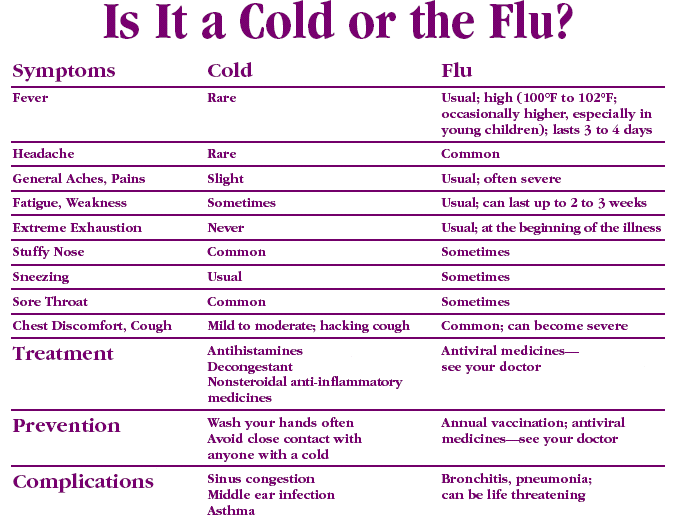
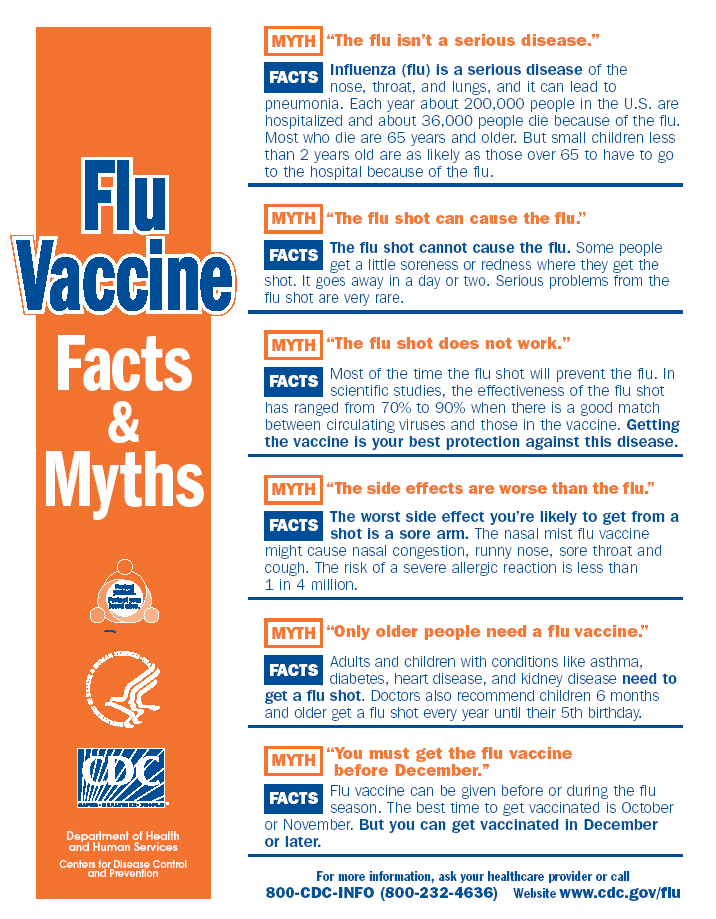
Credit: CDC, NIH, Food and Drug Administration
